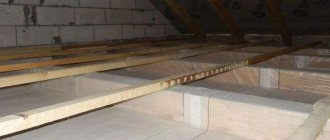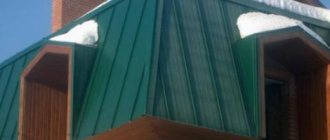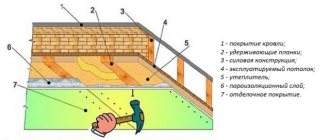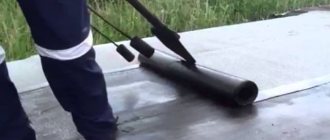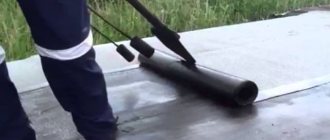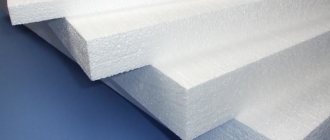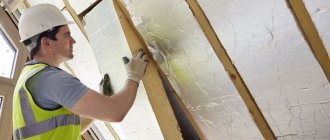Metal tiles are in increasing demand. This material meets almost all consumer needs. It is aesthetic, durable; with its help you can clad the roof in any style - the variety of profiles and shades allows you to implement any design solutions. Metal tiles are resistant to the destructive effects of moisture and ultraviolet radiation; they are used in any climatic conditions. Easy installation is an additional advantage of the material; Installing metal tiles will not take much time. In this article we will look at how to properly lay metal tiles.
What to do with a complex roof shape
Let's tell you frankly: metal tiles are far from the best roofing material for a roof with a complex shape.
Therefore, since there is already one and it needs to be insulated, be sure to think about the ventilation of all its parts. Definitely everyone! The fact is that certain areas without ventilation will be warmer; snow will melt on them and flow down to the eaves, where there is ventilation and the roof covering has a lower temperature (especially on the overhang, under which there is no insulation). And with metal tiles for water, it’s not difficult to find an entrance to the under-roof space.
Further, the melted snow will encounter unmelted snow and remain there, eventually turning into ice. And putting it on is not only a danger for people living in the house when they go outside at the wrong time - it is also a constant destruction of the drain.
This is why the ventilation of a complex roof must be 100%, without missing a single section. To do this, install an intermittent counter-lattice, which allows air flows to move not only in one specific direction, but also in different directions, reaching all zones. Also, a couple of additional aerators will not be superfluous.
And after finishing the insulation, also make sure that the air intake hole in the eaves is always open. It cannot be hemmed with a board, but it can be covered with a slightly bent gutter drip.
As a last resort, we advise you to insulate such a roof from the inside using polyurethane foam, which penetrates into all cracks and hard-to-reach places (and a complex roof always has them), and is not afraid of moisture:
Choosing the right insulation
Here we come to the main question. For convenience, let's break it down into separate important points.
Sorptive humidity of insulation
Do you know why wet insulation quickly loses its thermal insulation properties? The fact is that the thermal conductivity of water is exactly 25 times greater than that of air - that's one, and the water itself seems to glue the fibers together - that's two. That is why, when choosing insulation for a roof, carefully study its three main qualities: sorption humidity indicator, vapor permeability and water absorption. After all, on a roof with metal tiles as a roof covering, the issue of dampness is acute. Not to mention the constant condensation on the metal surface, which always finds a way to get to the insulation through invisible holes in the waterproofing.
So, sorption humidity is the hygroscopic humidity of insulation under certain conditions. Those. the higher this value, the worse, because for roofing insulation, water-repellent properties are primarily important. And they are directly affected by the presence of special hydrophobic additives in the material.
For clarity, let's look separately at the issue of humidity in a typical home. So, according to sanitary requirements for residential premises, normal humidity is 30-45%, and 30% is the threshold below which the air becomes too dry and even unfavorable for health. But in European countries, 45-60% is considered normal humidity. But keep in mind that the humidity level in the house can reach 80%, especially if more than two people live together and the wall decoration is almost vapor-tight. The moisture simply has nowhere to go, and it rises up to the roof, which then leads to problems with the insulation, if you think through the roofing pie well. You remember how a metal roof loves to collect condensation under it?
Of course, all responsibility can be immediately shifted to the vapor barrier. For example, aluminum is considered one of the best:
Water-absorbing properties of insulation
But I’ll have to disappoint you a little: not a single vapor barrier in the world can protect the insulation 100%. Real figures are in the range of 70-80% if the vapor barrier is of high quality, and 50-60% if it is the simplest
And, if we take into account the fact that such insulation is still affected by condenser moisture on the other side (metal tiles again), then you need both high-quality vapor barrier and insulation, which, as far as possible, is not afraid of water and retains its properties for a long time even in such extreme conditions
And this is already such a quality of insulation as water absorption - this is the ability of the material to absorb moisture upon contact with water and retain it. The lower the water absorption of the insulation, the better - this way it will stay dry for as long as possible, even with high dampness. In this regard, polystyrene foam, for example, is a leader among other insulation materials.
So, in addition to polystyrene foam, stone fiber naturally has water-repellent properties, which only need to be slightly enhanced. Here are step-by-step instructions on how to insulate such a roof:
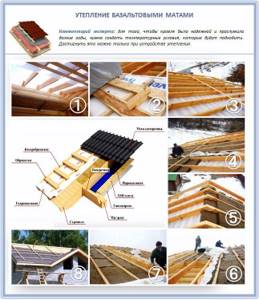
Vapor permeability of insulation
And finally, vapor permeability is the ability of insulation to pass water vapor through itself and remove it out into the ventilation opening. This is one of the most important factors that affect the thermal insulation of a roof. And in such a roofing cake, vapor permeability should also be high!
Modern ecowool is one of the best in this regard:
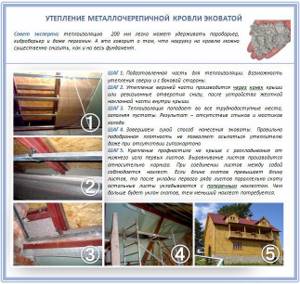
Cleanliness of insulation
There is another problem: some insulation materials generate dust, and their lint particles, together with warm air, rise and gradually clog the vapor-permeable holes. As a result, over the years, the quality of even the best “breathable” membrane deteriorates. Therefore, it is better not to insulate such a roof with sawdust at all, like with cheap mineral wool. Only from well-known manufacturers!
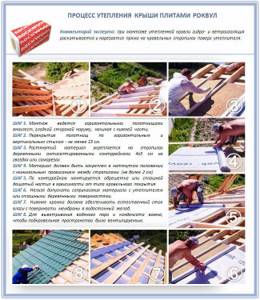
And special under-tile fastening systems, which are just beginning to appear on the Russian market, but have long been recognized abroad, are well suited in this regard:
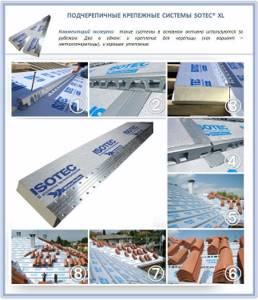
Let's summarize: the lower the indicators of water absorption and sorption humidity, and the higher the vapor permeability, the better the thermal insulation qualities of the material for insulating a metal roof. Choose the right material, study our photo instructions - and go!
How to care for your roof
The polymer coating of the metal tile protects it from rust, but is itself exposed to temperatures, ultraviolet radiation and weather disasters.
Regular cleaning consists of the following simple steps:
- Dried leaves and ordinary dirt are removed with a damp brush with hard bristles;
- Snow is cleared using conventional soft snow clearing devices;
- To wash gutters, use a stream of water under pressure, which is directed from the ridge of the roof towards the eaves;
- Heavy dirt can be removed using gentle polymer surface products;
- Aggressive household chemicals should not be used: they can destroy the protective layer of the roof.
Installing additional items
Installing a valley: constructive tips
It is installed at the junction of the slope to the slope, but always together with the overlays. The lower valley strips are laid on the sheathing so that its lower edges are on top of the eaves strips. Then a sealant must be placed on the lower valley slats - it ensures a tight fit of the sheet to the slats. By the way, the valley is attached at the top of the profile wave in increments of 300 mm.
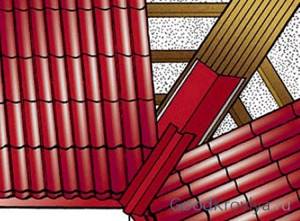
The joint of roofing sheets looks unaesthetic and therefore requires decorative treatment, which consists of laying a strip of the upper valley
End strip
Here it is necessary to use a “bottom-up” scheme, and the overlap of the planks is at least 10 cm in length. The end strip is attached to self-tapping screws in increments of 40 cm.
Something about the eaves strip: proper water drainage
The eaves strip for metal tiles is a longitudinal structural element, the main function of which is considered to protect the frontal board from harmful wetting and from the penetration of moisture into the internal space. The essence of its fastening lies in the following points: the cornice strip is nailed to the front board in a checkerboard pattern (step 300 mm); First, one plank is nailed, then the other is laid overlapping.
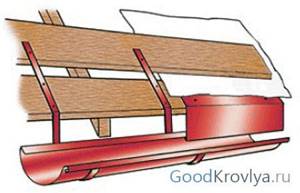
Under-roof waterproofing is laid on the last board of the sheathing and the eaves strip
Horse - say no to leakage
Small gaps must be left at the joints of the ridge. The seal is firmly glued to the upper edges of the sheets, the ridge is fixed with self-tapping screws at the apex points through the wave.
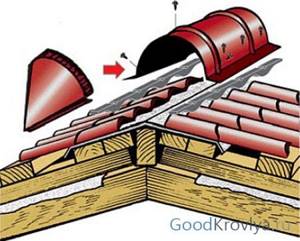
A seal with ventilation holes is placed on the ridge, onto which the ridge strip is subsequently attached.
Snow guards - such components should not be neglected
The planks are attached under the second transverse steps of the profile sheets, and a support strip is attached between them at the top of each wave. In addition, the installation of protective snow retainers can be carried out directly to the sheathing: naturally, then it is advisable to use long roofing screws.

Snow guards are installed in places such as the space above the entrance and windows, as well as at each level of the roof if it consists of several levels
In general, all of the above can be summarized unambiguously: installation of metal tiles is a complex process that requires skills, knowledge, and experience. You can’t master it on your own, so it’s better to immediately turn to professional craftsmen, because then the final result will be excellent and pleasing to the eye!
How to insulate a roof, design tips
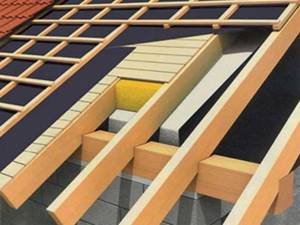
It is laid on the supporting roof frame - the rafter system. It is recommended to insulate a metal tile roof using a roofing pie made between the rafters. This technology is considered the most effective and gives excellent heat saving results. We can say that in the end, the maximum preservation of heat depends on the filling of the pie. Properly selected and installed, it prevents cooling of the living spaces of the attic and attic, prevents the penetration of moisture from the outside and ensures its removal directly from the pie itself.
The main layers of the roofing pie
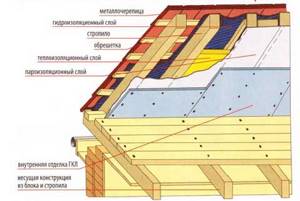
It is impossible not to note the roofing material itself – metal tiles. The extent to which the roof and the elements of the “filling” of its roofing pie will be protected from the aggressive effects and physical stress of natural phenomena, snow, rain, and wind largely depends on compliance with the technology of its installation. The safety, absence of wetting and effectiveness of the thermal insulation layer are ensured by a waterproofing film, one or two ventilated gaps (depending on the type of waterproofing material) and vapor barrier material.
Waterproofing a metal tile roof is designed to prevent moisture from entering from the outside. Depending on the purpose of the attic space, it can be either vapor-tight or vapor-permeable.

The waterproofing film is attached to the rafters at the top using staples or galvanized nails. In this case, it is necessary to allow a slight sagging of the canvas up to 1 cm in order to protect it during temperature changes. The sheets are laid across the roof slope with an overlap of the top sheet on the bottom sheet by 10 cm. It is desirable that the waterproofing material have high vapor permeability, otherwise it will be necessary to provide another ventilated layer in the roofing pie.
On top of the waterproofing layer, counter-lattice bars are laid along the rafters, and sheathing bars are laid across. The height of the counter-lattice bars is selected based on the length of the roof slope and the size of the required ventilation gap, and the pitch of the lathing in accordance with the horizontal wavelength of the metal tile, since the roofing material will be attached to it.
For a metal roof, it is especially important to have ventilation for the under-roof space. In its absence, condensation, which forms when the internal and external temperatures differ on the inside of the metal tile, can lead to disastrous consequences for the roof structure
For metal roofs, including those made of metal tiles, it is necessary to use special membranes - anti-condensation membranes.
This material is one-sided, and it should be laid with the rough side facing the insulation.
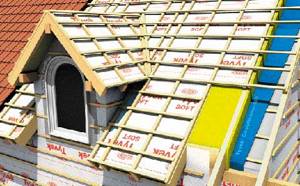
Thermal insulation layer of a metal roof
It is recommended to make it from breathable materials, usually with a fibrous structure. They are based on basalt or fiberglass. These insulation materials have good thermal insulation characteristics and excellent noise reduction. Another advantage is that they are not flammable. The total thickness of the mineral wool layers under the metal tile roof of an energy-efficient house is at least 20 cm. Fiberglass insulation, due to its structure, has many air gaps, which ensures their low thermal conductivity.
In general, the performance characteristics of mineral wool and fiberglass are similar, although the thermal conductivity of fiberglass is lower.
Penoizol is also used as insulation - liquid foam, a new generation of thermal insulation material.
It is necessary that the thermal insulation mats or slabs be semi-rigid. This way they will hold well in vertical and inclined planes.
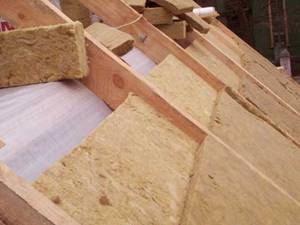
Their length should be 2–3 cm greater than the distance between the rafters. The number of layers of insulation to be laid is calculated depending on the thermal conductivity coefficient of the material used for insulation.
Vapor barrier layer of a metal roof
protects the insulation from moisture that comes from inside. It is also attached to the rafters, only from below, using galvanized nails or staples. Similar to laying the waterproofing film, an overlap is performed. To ensure tightness, all “dangerous” junction areas, for example, to walls, pipes, windows, are taped with special tape.

The installation of the roof, insulation and other elements is carried out without deflections, gaps and irregularities with a tight fit to each other, with the exception of ventilation ducts.
2019stylekrov.ru
What is the best insulation for metal tiles?
If you are planning an attic floor, what is better to choose? So that you could stay there in winter, and that it would be safe in terms of flammability and health.
To insulate the roof of a house that will be covered with metal tiles, it is best to use “Ursa” insulation. The basis of this mineral insulation is staple fiber. The material is environmentally friendly, non-flammable and lightweight, which is especially important when using it on the roof. Has good thermal conductivity characteristics. Depending on the purpose of the room, different thicknesses of insulation can be used.
You can use any material intended for thermal insulation of residential premises. The thickness of the material is selected according to its thermal insulation properties; this parameter must be present in the attic design. Naturally, the insulating material itself does not heat, so it is necessary to provide heating for the attic.
All these tasks are solved in a working order and do not pose much difficulty. It is much more difficult to perform thermal insulation and waterproofing efficiently, so that condensation does not form, and if it does appear, it is removed without problems. In a residential attic, condensation will certainly form on any non-insulated surface, i.e. the slightest crack in the insulation will allow moisture to enter the metal of the roof and inevitably the appearance of fungus or mold, which is not at all safe for health.
Materials for thermal insulation of pitched roofs
Roof insulation technology involves the use of various materials. The most popular heat insulators include mineral wool and glass wool (in slabs or rolls), slab polymer materials - polyurethane foam, polystyrene foam. The principles of their installation are similar, but it is worth noting that installing slab material is much simpler and more convenient.
As waterproofing, roofing material or a waterproofing membrane is usually used, which is impermeable to water, but capable of removing moisture from the insulation. The vapor barrier layer can be made of
:
- roofing felt;
- polyethylene film;
- glassine;
- foil materials laid with foil towards the attic.
To create a roofing pie with high functional characteristics, it is recommended to use a special vapor barrier membrane to create a vapor barrier: it removes condensation outside from the insulation and does not allow steam and moisture to pass into the roofing pie.
Let's sum it up
How high-quality and functional the insulated structure will be will depend entirely on how correctly and conscientiously the thermal insulation work is carried out. Saving on roof insulation is not the most reasonable option. A well-insulated roof will significantly reduce the cost of heating your home. If you choose metal tiles, it is recommended to insulate using fibrous heat insulators (glass and mineral wool). Such materials are distinguished by their reliability, long service life and excellent sound insulation qualities. It is also worth remembering that these materials are not subject to combustion, which is also important in private construction.
Calculation of the amount of metal tiles
To calculate the required number of sheets of material, you first need to decide on the type of profile and the manufacturer of the metal tile - you will need the exact dimensions of the material itself, and each profile has its own. Then you need to make accurate measurements of the slopes - length, height, if any, you need to measure all the protrusions or other decorative elements that will need to be sheathed with roofing material. If the roof has a complex shape, it is better to draw a plan, put down all the dimensions and then start doing the calculations.
Number of rows
It is best to look for metal tiles not in stores or markets. It is advisable to contact the manufacturer directly. The point is not only the price - it may not differ very much, but the fact that many workshops/factories offer to cut sheets of the required sizes. The minimum sheet height is 0.7 m, the maximum is 8 m. That is, you can order the required number of sheets covering the roof slope from the ridge to the overhang (taking into account the eaves overhang).
This option is good because a metal tile roof will not have horizontal joints, which means there will be less chance of leaks. The second plus is a minimal amount of waste and a smaller amount of material itself (due to the absence of horizontal overlaps, several square meters are saved). Disadvantages: difficulties with delivery, lifting long sheets to the top, inconvenient installation.

Calculation of a rectangular roof slope
When using sheets of standard sizes, the height of the roof slope is divided by the useful length of the sheet. The resulting figure is always rounded up. The useful length is obtained after subtracting the amount of horizontal overlap from the total length - from 100 to 200 mm. The flatter the slope, the greater the overlap of the sheets is necessary so that precipitation cannot get into the under-roof space. On roofs with a slope of up to 12°, one sheet overlaps the other by at least 200 mm; with a slope of 12° to 30°, the overlap is 150-200 mm, more than 30° - 100-150 mm. The specified amount of overlap is subtracted from the total length of the sheet, this will be the “useful length”.
An example of calculating the number of rows of metal tiles on a roof. Let the length of the slope be 4.5 m, the useful length of the sheet is 2.3 m. Divide 4.5 by 2.3, we get 1.95, round to the nearest whole number - we get 2 rows. In this case, only a small part of one sheet will go to waste, but there are times when more than half is cut off. This is very unprofitable, since this piece cannot be used anywhere else.
Number of sheets in a row
Take the length of the slope and divide it by the usable width of the sheet. This parameter is indicated in the technical specifications for metal tiles. Most often it is 110 cm (1.1 m). We round the resulting number up to obtain the number of sheets in the row.
An example of calculating metal tile sheets in a row. Let the length of the overhang be 8 m, the useful width of the sheet 1.1 m. When dividing, we get 7.27 pieces, but round up to a larger integer and we get 8 pieces in one row. Moreover, more than 2/3 of one sheet will go to waste.
Features of hip roofs
Hip roofs have slopes that are triangular or trapezoidal. Here it is necessary to select the length of the sheet in order to minimize the amount of waste.
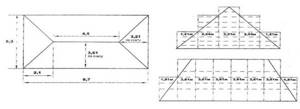
An example of the layout of metal tile sheets on a hip roof
The height is selected so that no more than half goes to waste. It is quite difficult to do this manually, and there is still a significant error - there will be 20-25% more waste than when calculated using programs. They are usually available from sellers and manufacturers. It is better to provide them with an accurate calculation, and first measure the parameters of the roof at home (or call a measurer), and then try to select the dimensions yourself. Then you can compare the amount of material needed, calculated by you and proposed.
Determining the number of additional elements
A metal tile roof requires a large number of different additional elements (additions), which form the ridge, the edge of the overhang, the sides of the slope, the passage of the pipe, the valley (the junction of two adjacent roof slopes). The more complex the shape of the roof, the greater the amount of additions required. With a simple gable roof, ridge elements and caps, cornice and pediment strips will be needed. That's all.

What types of additional elements are there for metal roofing and why are they needed?
Despite the wide variety of extras, they are all considered the same. Take the length of the surface on which it needs to be mounted and divide by the useful length of the element. It is usually standard and is 1.9 m (total length 2 m). The result obtained is rounded up.
Design of security elements and their purpose
Ladder
To climb to the roof, you need a stable ladder. It consists of wall and roof ladders with brackets. 4 brackets are required per section; they are placed in the place of the lower wave bend, where the sheathing is solid. Both the brackets and the top of the roof ladder are secured with bolt screws. The wall staircase is installed so that the topmost step is opposite the edge of the cornice. In this case, the wall staircase itself must be aligned with the roof staircase.
Roof fencing
These metal elements are a necessary condition when working on the roof. They are secured using special supports to the continuous sheathing through the lower part of the wave, sealing with a rubber gasket. See photo above.
Transition bridge
Walking bridges are needed for safe walking on the roof from an attic window, hatch or staircase. They are fastened in the same way as fences, only continuous sheathing is not necessary.
Snow guards
Snow guards have a tubular design and are made of metal painted black, brown, red or green. They are installed along the entire perimeter of the roof, above the eaves overhang. In addition, they must be placed above the entrance to the house, attic windows, as well as above each level of a multi-tiered roof.
>Metal Profile roofing system diagram
Below is a diagram of the roofing system of the Metal Profile company. On it, all the nodes discussed above are connected into a whole roof.
Insulation of a flat roof
What should you use?
- Load-bearing base.
- Vapor barrier.
- Roll material (roofing felt).
- Insulation.
The bulk layer on a flat roof consists of a cement-sand mixture and a drainage layer.
The order of layers in the “roofing pie” depends on the type of roof. In the traditional type, the insulation is protected by a waterproofing carpet, and in the inversion type, the opposite is true.
How to insulate a roof
Insulation of flat roofs.
To begin with, the roof should be thoroughly cleaned of excess moisture, foreign objects and dirt. This point should be given special attention; excess moisture will saturate the space in the under-roof layer with moist steam and penetrate into the open pores of the insulation
As a result, this can even lead to swelling of the roof covering and the formation of air pockets, which can significantly affect the insulation. Next, a waterproofing coating should be applied to the insulation; it is important to do this immediately, avoiding any contact of water on a flat surface. To distribute the load evenly, during installation, workers must move strictly along the inventory walkways. It is important to lay the thermal insulation towards yourself, starting from the edge opposite to the roof exit.
These simple rules require very careful study, but your efforts will not be in vain, and in return you will receive high-quality thermal insulation.
Often, when installing roofing materials, big problems arise, and as a result, you have to change the rafter system, which has worn out and completely deteriorated due to insulation that was previously done incorrectly
Therefore, roof insulation must be approached with great care. On the roof of a private wooden house, the rafters may become damaged, the sheathing may become unusable, and all this in literally just 5 years
Therefore, it must be installed correctly and on time, as soon as the team completes the rafter system. and the insulation can be installed after the roof is installed.
Share a useful article:
Installation stages
Let's figure out how to properly install metal tiles so that they last a long time. When laying the membrane to protect against moisture, it should be taken into account that it should remain with a slight sag, about 20 mm. In this way, it will be possible to ensure the drainage of condensed moisture, thereby protecting the rafter system and other roofing elements from rotting. To allow water to evaporate in a timely manner without stagnating and thereby creating an unfavorable environment, care should be taken to include in the design a ventilation gap, which is placed between the moisture-repellent film and the roof ridge.
This technology for installing metal tiles implies that the clearance will allow air flows to easily circulate in the space under the roof, removing all condensation. The laid membrane must be free of ruptures and other damage. To secure it, it is best to use a construction stapler. The layers of the membrane are laid with a slight overlap, and its edges are sealed with tape.
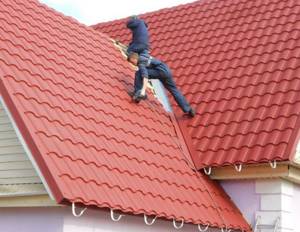
The design of the roof with a cold attic is such that it can be used in regions with any climatic conditions. Quite a lot of people believe that this type of roofing is not applicable to northern regions, although in fact this is not the case. Often, cold attic spaces are most often installed in such regions. The attic itself is insulated, and the cold roof does not in any way affect the internal microclimate of the upper floors. You don’t even have to use the attic, because laying a layer of insulation between the top floor and the under-roof space eliminates all the nuances that affect heat loss.
When installing a cold roof made of metal tiles, it is necessary to take care of the thermal insulation of ventilation openings, chimneys and exits to the attic. In this case, you will not have to worry about the accumulation of condensation, icing, heat loss, or the flow of rain and melt water.
A cold roof can be covered with almost any roofing covering, but metal tiles, due to the ease of installation, are used much more often. Some other types of roofing materials, in particular soft roofing, are also well suited in this situation, but they require a lot of time and money during installation.
Stages of work on insulating a pitched roof
The roof insulation scheme is quite simple. First of all, you need to measure the distance between the rafters. The slabs of cotton wool insulation should be cut according to the results obtained, adding 1 centimeter. This will allow you to fasten the heat insulator between the rafters. This stage of work is greatly simplified if the roofing system is initially designed and installed based on the use of slab insulation boards of a certain width.
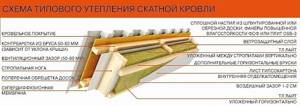
If there is no waterproofing between the rafters and the already installed roofing, you should first secure a water barrier. The membrane should envelop the rafters; it is most convenient to fasten it with a construction stapler to the rafters themselves and to the roof sheathing in the openings between them. The waterproofing must be installed under the eaves at the bottom of the roof to ensure moisture drainage. It should be taken into account that with this method of fastening the hydrobarrier, the insulation must be installed without the necessary air gap. For this reason, it is recommended to use a superdiffusion membrane as a waterproofing material.

If there is a waterproofing layer under the roofing, nails are placed on the rafters in increments of about 10 cm. The nails should be located at a distance of 3-5 cm from the waterproofing layer. It is necessary to stretch a polyethylene thread or cord between the nails, tamping them to the end. This will help create an air gap between the hydrobarrier and the insulation. If the heat insulator is planned to be fixed with a cord, and not with lathing for internal cladding, nails must also be driven along the outer edge of the rafters.
If, when deciding how to insulate the roof of a house, you chose cotton slab insulation, then the prepared elements must be slightly compressed and inserted between the rafters
When using stiffer foam boards and similar materials, it is important to accurately size them so that the boards fit snugly into the opening. It is recommended to carry out insulation in two layers
If you have to mount not solid sheets into the opening, but narrower fragments, joining them along the length or width, you need to make sure that the joints of the second layer do not coincide with the joints of the first. The heat insulator should not protrude beyond the plane of the rafter legs. If the rafters are not wide enough to install two layers of insulation, additional timber is nailed to them.
The heat insulator is fixed between the rafters using a stretched cord secured to pre-filled nails. Or, as a fastening, a lathing made of slats is used, intended for mounting the interior lining of the room. The slats are nailed to the rafters in increments of 30-40 cm. In this case, the vapor barrier is stapled to the rafters before installing the sheathing: the thickness of the slats allows you to create the necessary air gap between the vapor barrier and the sheathing.
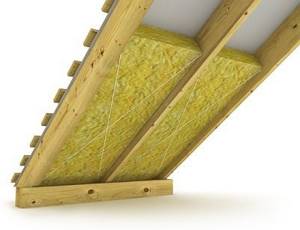
When installing a vapor barrier, special attention is paid to the tightness of the layer. The panel is laid with an overlap of at least 10 cm, the joints should be taped with adhesive tape in two layers
It is necessary to install the vapor barrier around the chimney and at the junction with the walls as efficiently as possible. At the final stage, the sheathing is installed using wood-based or plasterboard boards.
You can learn more about how to insulate the roof of a house from the video.
We thermally insulate a steel tile roof
Insulating such a roof is a simple construction project that, however, requires compliance with a number of rules:
- installation of heat-insulating materials is carried out between rafters;
- When laying the insulator, it is important to ensure that it is not wrinkled or deformed, since minor damage can lead to heat leakage;
- when cutting material for roof insulation, the width of the tolerances should be 0.7-1 cm, as they will help insert the insulator between the rafters;
- in order not to crush the heat-insulating board, mount the middle of the product in the span between the rafter structures, after which the plate is pressed from the center to the edges;
- if mineral wool is used, then first insulation is installed between the rafters directly under the tiles, and the next layer is mounted on the inside between the counter-battens.
Laying technology
The laying of metal tiles is carried out after the assembly of the rafter frame and sheathing is completed. To avoid getting the wooden frame elements wet, installation should be carried out in dry weather. For safety reasons, it is prohibited to carry out work at height in windy weather. To lay the metal profile with high quality. There is the following instruction:
- Waterproofing material is laid on top of the rafters, starting from the roof overhang. Laying is done with a slight sag so that the waterproofing does not burst under water pressure. The film is attached to the rafters with a stapler; an overlap between the strips is made of 10-15 cm, gluing it with adhesive tape.
- Counter-lattice slats are installed along the rafters directly on top of the waterproofing, which form a ventilation gap necessary to protect the roofing material from condensation.
- Then, perpendicular to the rafter legs of the frame, the lathing is fixed to the counter-lattice with a step equal to the wavelength of the metal profile.
- Metal tile sheets are cut to fit the dimensions of the slope. If you buy the material directly from the manufacturer, then the cutting is done at the factory, so there will be no horizontal joints between the sheets. You can cut metal profiles outside of production with a circular saw, jigsaw or hacksaw.
- Begin laying from the lower right edge of the slope. If laying is done in one row, then the sheets are attached one after another. If the installation is carried out in 2 rows, then first lay the outermost sheet at the bottom of the slope, then fix the sheet above it, then the 2nd sheet of the first row, and so on.
- The sheet is attached to the sheathing using roofing screws with a rubber press washer, which closes the fastening hole from water penetration. The screws are screwed in strictly at right angles to the surface of the roofing material, leaving a gap of 1-2 mm so as not to deform it. To fix 1 sheet, 10-15 screws are required.
- During installation, metal tiles overlap each other by 1 wave. The place where the sheets overlap is fixed with self-tapping screws through a capillary groove.
Note! When fixing metal tiles, it is important not to twist the self-tapping screw to avoid deformation of the material and chips on the polymer coating. To do this, it is better to use a screwdriver at low speeds.
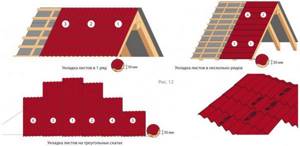
Material laying technology

Sheet fastening scheme

Location of attachment points
Expanded polystyrene
This material plays a fairly significant role in any construction. Not every insulation has such excellent characteristics and such an affordable price. When carrying out thermal insulation measures with your own hands, you can significantly reduce the monetary costs of operating a building, and selecting high-quality insulation will help save electricity, which is expensive in these days, and roof insulation will help with this. Metal tiles are a material that will be quite profitable in economic terms due to the price-quality ratio.
conclusions
So, what is the best roof insulation? You can choose the option, like most, and use mineral wool. If we are talking about insulating the floor on the roof, pay attention to ecowool . When calculated, its cost is not that high. But this is an environmentally friendly material that is not afraid of rodents. And this is a big plus. We have given enough general considerations to help you choose insulation. However, no matter how correctly the chosen material is selected, when laying the insulator it is important to adhere to the installation rules, which we described separately.
As we found out, roof insulation can be not only buns with hot chocolate, but also at least 6 other good materials. Choose and let your roof be as warm as Carlson’s.
An important element of the roof sheathing
To create the sheathing, use bars with a cross-section of 50/50 mm and edged boards measuring 32/100 and 50/100 mm. At the bottom of the roof slope, along the eaves overhang, two 50/100 boards are nailed. Then a counter-lattice made of 50/50 mm bars is placed on top of the waterproofing. The bars are nailed along the rafters, from the ridge to the bottom. On top of this counter-lattice, with a certain step, sheathing boards are attached horizontally. The fastening step of these boards will depend on the type of metal tile profile that is planned to cover the roof.
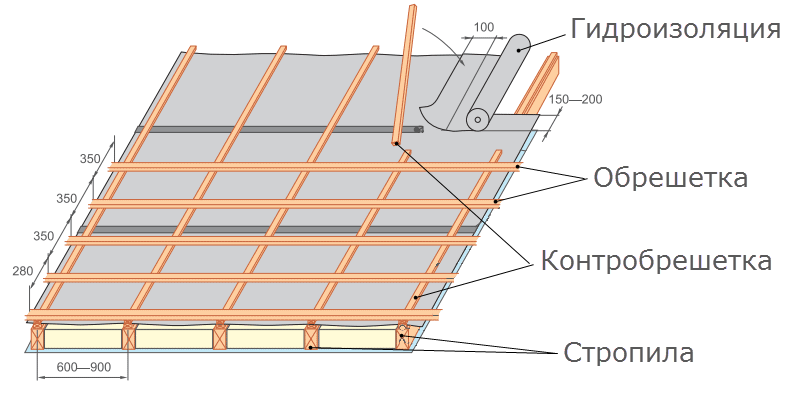
Ridge sheathing
The uppermost part of the roof requires strengthening. To do this, you need to nail a pair of boards on each side of the ridge strip.

From the end of the roof you need to nail boards larger than the main sheathing to the height of the metal tile profile.

The valley is the internal junction of two roof slopes. Where the valley passes, the sheathing is made continuous.

Roof fencing
It simply must be reliable, so it is made above the overhang of the eaves. As a guide, you can take the height of the load-bearing wall. The sheathing in these places needs continuous sheathing. Therefore, additional boards are added between the ordinary sheathing and a continuous base is made.

Types of waterproofing substrates
In a high-quality roof, it is necessary to provide for the formation of condensation not only directly under the metal tiles, but also from the insulation side.
To do this, first of all, an anti-condensation layer is applied to the inside of the film and a gap is left for ventilation. The formation of condensation depends on whether the roof is warm or cold. Its intensity and volume are directly related to the temperature above and below the substrate.
There are three types of films in total:
Classic film
It is important to maintain ventilation in two circuits:
- Between roofing material and waterproofing
- Between waterproofing and insulation
Selection of thermal insulation material
To thermally insulate a roof with a cover made of metal tiles, it is better to use thermal insulators with a fibrous structure. The most common of them:
- glass wool;
- mineral wool.
Minvata
Mineral wool and similar materials with a fibrous structure have remarkable thermal insulation properties. They very effectively remove excess moisture from under the roof space into the external environment. A specific membrane fabric film will prevent condensation from remaining inside the building.
When performing roof insulation work on the inside of the attic space, the mineral wool must be cut in advance into fragments having the required dimensions with an allowance of 2 or 3 centimeters. Before installing the insulating material in the gaps between the rafters, it needs to be compressed a little. Upon completion of installation work, the insulation will expand again and completely occupy the space intended for it.
Styrofoam
As a material characterized by ease of self-installation and affordable cost, you can use the well-known polystyrene foam. It weighs little, is produced in the form of slabs and does not create additional load on the roof structure.
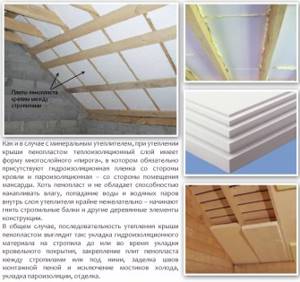
Polystyrene foam also has its drawbacks:
- low vapor conductivity, which threatens the accumulation of condensate under the roof and dampness in the house;
- the material attracts rodents who like to build their nests in it, which will significantly damage the insulation of the attic..
Polyurethane foam
This material can be applied in foamed form to any surface being processed, regardless of its shape and design complexity. The process takes place using a specific portable installation with a sprayer, from which the substance is supplied under significant pressure. In this way, it is possible to insulate the plane, regardless of its angle of inclination.
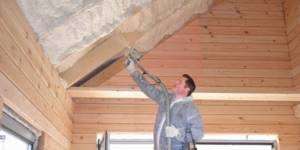
In addition, the use of polyurethane foam eliminates the need to lay a vapor barrier layer, which would protect the elements of decorative finishing of the living space from condensation penetration. The cost of such material is less economical than that of other materials used for heat insulation.
Ecowool
This building material is manufactured in a compressed form and will need to be loosened before being used for its intended purpose. Often, in order to return the material to its original shape, make it more voluminous and apply it to the insulated surface, special blowing equipment is used.

The technology for laying polyurethane foam and ecowool is not too complicated; the work can be done without the use of a structure for support. The use of insulation materials in rolls or panels will require more strict adherence to the rules of installation technology.
This is interesting: Types of alarm systems for dachas - we explain in detail
Some advice from professionals
When choosing insulation, you must also purchase ordinary or superdiffusion membranes. They are needed for vapor protection and waterproofing. Such layers must be made on both sides of the heat-insulating material. This will help prevent the appearance of condensation, so the surface of the insulator will not get wet and will not lose its qualities.
When attic rooms are insulated, the heat insulation is laid along the contours of the rooms. The ridge space should be left uninsulated. Vapor insulation is installed under the ceiling.
The waterproofing layer is made both under the roofing sheets and above the insulating material.
To prevent the heat insulator from getting wet, the inner part is covered with a vapor-proof film, and the outer part is covered with a waterproof film. The first counteracts the vapors that accumulate in rooms due to radiators. The second prevents external moisture from penetrating the surface of the insulation. Some vapor barrier manufacturers offer products that are coated with aluminum, and some of the heat is reflected back into the room.
Regardless of the cost of materials, deviations from generally accepted standards during the installation process are unacceptable. According to the layer-by-layer insulation technology, immediately after finishing the interior finishing, a special frame is installed on the roof surface, including wood blocks or a steel profile. The minimum gap between the roof structure and the frame is 1 cm.
The initial layer of the heat-protective “pie” is intended for vapor insulation and is made from ordinary polyvinylchloride film. An insulator is laid between the rafters, as mentioned above. It is covered with a vapor-permeable membrane to neutralize the effects of wind. The air gap is 5 cm. Then it is the turn of the wood sheathing. At the very end, metal tiles are installed.
Thus, the roofing “pie” consists of the following layers: vapor insulation, insulation material, vapor-permeable membrane, wood sheathing, steel tiles.
The order cannot be disrupted. It is only allowed to make changes that have a positive effect on the overall design.
Rules for working with heat insulators
When working with a heat insulator, you must follow a number of rules so that it fulfills its functions and the insulated roof serves you for many years.
Storage and installation
Firstly, moisture should not get on the surface of the materials either during storage or during installation, so the insulation must be stored in a room well protected from moisture.
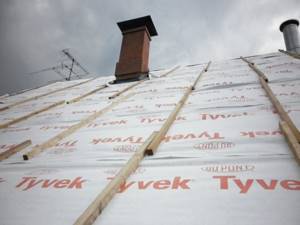
Preventing the ingress of moisture during installation is carried out by installing a waterproofing layer
It reliably protects the material from getting wet, preventing it from becoming saturated with water - this is a particularly important condition for the normal use of mineral wool.
Instructions
Before you start using, carefully read the instructions for the insulator. Many people believe that all insulation materials of the same type are the same, but this opinion is wrong. Only the goals of such materials are common, but the installation process, storage conditions and other important points are often different.
Handy tools
Never neglect the reliability of the tools at hand. No matter how high-quality the materials for insulating a metal roof are, if you cut them with a dull knife, nothing good will come of it, you will only ruin the insulator.
Safety regulations
Remember about basic safety rules that apply not only to the thermal insulation of roof structures, but also to any other construction activities.

We are talking about wearing safety glasses, durable gloves, a respirator, etc. Even a small metal chip that accidentally gets into the eye can cause serious injury.
Advantages of insulated metal roofing
Metal tiles are a popular roofing material made from galvanized steel. It is then coated with a polymer protective layer, which improves the properties and characteristics of the product.
The high demand for steel tiles is due to the many advantages of the material, from reasonable price to ease of installation. However, there are also disadvantages: for example, such a roof easily loses heat. To solve this problem, it is necessary to properly insulate the metal roof.

